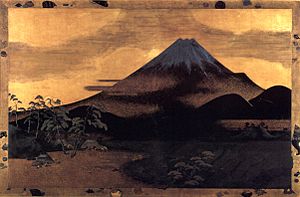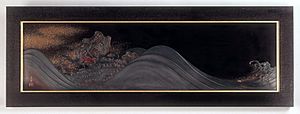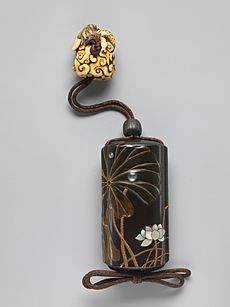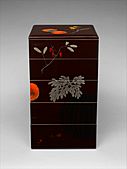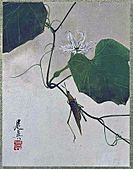Shibata Zeshin facts for kids
Quick facts for kids
Shibata Zeshin
|
|
|---|---|
| Born |
Shibata Zeshin
15 March 1807 |
| Died | 13 July 1891 (aged 84) |
Shibata Zeshin (柴田 是真, March 15, 1807 – July 13, 1891) was a famous Japanese artist. He was known for his amazing work with lacquer (a type of natural varnish) and also for his paintings and prints. He lived during the late Edo period and early Meiji era in Japan.
Many people call him "Japan's greatest lacquer artist." However, in Japan, some people had mixed feelings about his other art. Some thought he was too modern and liked Western styles, while others thought he was too traditional. But in Western countries, especially Britain and the United States, Zeshin is highly respected and studied.
Contents
The Life of Shibata Zeshin
Zeshin was born and grew up in Edo, which is now known as Tokyo. His family had a history of being skilled wood carvers and carpenters. His father, Ichigoro, was also a talented artist who painted in the ukiyo-e style. This background gave young Zeshin a great start in the art world.
When he was just eleven years old, Zeshin (whose childhood name was Kametaro) started learning from a lacquer artist named Koma Kansai II. This was his first step into the world of lacquer art.
Becoming an Artist
At age 13, Kametaro changed his name to Junzo. His teacher, Koma Kansai, believed that to be a truly great lacquer artist, Junzo needed to learn how to draw, paint, and create his own designs. So, he arranged for Junzo to study painting with Suzuki Nanrei, a famous artist from the Shijō school.
During this time, Junzo took on another artist's name: "Reisai." He combined parts of his teachers' names, Suzuki Nanrei and Koma Kansai, to create it.
It was while studying with Nanrei that he received the name "Zeshin," which he used for the rest of his life. This name means something like "this is true" or "the Truth." It comes from an old Chinese story about a king and many painters. One painter was very unusual and didn't bow to the king, but sat on the floor licking his paintbrush. The king was amazed and said, "Now, this is a true artist!" Zeshin's name came from this story.
Zeshin learned much more than just painting and drawing. He also studied the Japanese tea ceremony, haiku and waka poetry, history, literature, and philosophy. This broad education helped him understand not only the techniques of traditional Japanese arts but also their deeper meaning and beauty.
Many of his early works were paintings on fans. A famous ukiyo-e artist named Utagawa Kuniyoshi was very impressed by these fan paintings. He became friends with the young Zeshin, and their friendship lasted for many years.
Facing Challenges and New Ideas
Zeshin later studied with other great artists from the Kyoto school. Even though he became most famous for his lacquer work, he was also excellent at traditional ink painting. He created many ink paintings of subjects like tigers and waterfalls.
In 1835, his first lacquer teacher, Koma Kansai, passed away. Zeshin then took over the Koma School workshop. He also took on a young student named Ikeda Taishin, who remained his student and close friend for many years.
In the 1830s and 1840s, Japan faced money problems. Laws were made that limited how much silver and gold artists could use. These metals were very important for traditional lacquer art. Zeshin found clever ways around this. He used bronze to make things look like iron, and he used other materials and styles to keep his art beautiful and traditional.
Many of his pieces from this time show the idea of wabi, which means finding beauty in simple things. This is a key idea in the Japanese tea ceremony. Even though few of his early works survived, his later art shows that he sometimes used very simple, almost colorless designs, while still using traditional patterns like flowers.
Working for the Government
Starting in 1869, Zeshin was asked to create art for the Japanese government. He made many beautiful pieces, including gold-lacquered chairs for the Imperial Palace decorated with sakura (cherry blossom) designs.
He was also chosen to represent Japan at several international art shows, like those in Vienna (1873), Philadelphia, and Paris. He didn't go to these shows himself, but his art did.
Just one year before he died in 1891, Zeshin received a huge honor. He became a member of the new Imperial Art Committee. He is still the only artist recognized for his skills in both painting and maki-e (a type of lacquer art). This honor was only given to 53 artists between 1890 and 1944.
Today, one of the largest collections of Zeshin's art is in the Khalili Collections in London. It has over 100 of his works.
Zeshin's Unique Art Style
Zeshin was always experimenting with how he used lacquer. He mixed it with different things to get new colors and textures. He also found a way to paint with lacquer directly on paper, which was very difficult. This stopped the lacquer from flaking off when his scroll paintings were rolled up. He even used bronze in his lacquer to make it look like iron, and cereal starch to make it thicker, like Western oil painting.
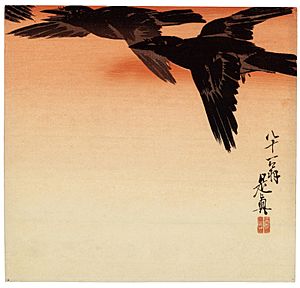
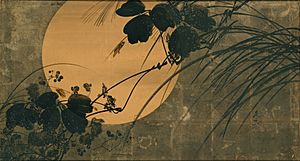
Zeshin is the only artist who was truly successful at urushi-e, which is painting with lacquer. It needs special paper and a very specific type of lacquer. Zeshin also brought back a difficult lacquer technique called seikai-ha. This technique creates wave patterns by dragging a comb through the quickly drying lacquer. It was so hard that no one had used it for over a hundred years!
Even though Zeshin used many new and experimental ideas in his work, his art was always very traditional overall. In his new lacquer paintings, he would often paint classic Japanese subjects like birds, flowers, insects, waterfalls, and dragons. He even copied a famous painting of a tiger by his teacher, Maruyama Okyo, using lacquer.
A red, black, and gold lacquer picnic set made by Zeshin shows this mix of new and old. The set looks very traditional, mostly red and black lacquer with gold leaves and branches. But on the serving tray, there are butterflies and dragonflies made from shiny seashell, set into the surface. This was a new way to add detail.
Zeshin's signature was usually quite small and hidden. Sometimes, he would even play around with it. On a decorative tsuba (a sword handguard) he made, there's a tiny ant carrying away part of his signature to the other side of the piece!
Many people say that Zeshin's art shows the Japanese idea of iki (粋), which can be thought of as "chic" or "cool." It means having a perfect balance of tradition and newness, being beautiful but not too flashy, simple but not boring, and smart but not arrogant. His style has been compared to haiku poetry, where the beauty and meaning come from what is suggested, not just what is directly shown.
Zeshin is considered one of the three greatest lacquer artists of his time in Japan, along with Nakayama Komin and Shirayama Shosai.
Exhibitions of Zeshin's Art
Zeshin's artworks have been shown in many museums and galleries around the world.
- Japanese Lacquer, 1600-1900: selections from the Charles A. Greenfield collection, September 4 to October 19, 1980, Metropolitan Museum of Art, New York.
- Shibata Zeshin: Masterpieces of Japanese Lacquer from the Khalili Collection
- April – October 1997, National Museums of Scotland, Edinburgh, UK.
- October – November 1999, Toyama Sato Art Museum, Toyama, Japan.
- November 2000 – March 2001, Roemer and Pelizaeus Museum, Hildesheim, Germany.
- The Genius of Japanese Lacquer: Masterworks by Shibata Zeshin Japan Society, New York (March 21 - June 15, 2008).
Gallery
-
Flowers and Birds of the Four Seasons, Tokyo National Museum
-
Shōki, 1865, British Museum
-
Jurōjin by Shibata Zeshin, 1887, painting, ink and color on silk (Honolulu Museum of Art)
See also
- Hashimoto Gahō
- Takeuchi Seihō


